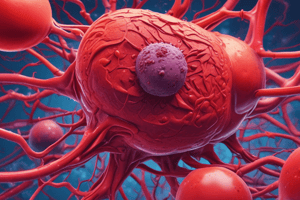Podcast
Questions and Answers
What is the main role of plasmin in the fibrinolytic process?
What is the main role of plasmin in the fibrinolytic process?
- To cleave crosslinked fibrin into degradation products (correct)
- To activate plasminogen
- To bind to fibrinogen
- To form new fibrin polymers
Which factor inhibits the activity of tissue plasminogen activator (t-PA)?
Which factor inhibits the activity of tissue plasminogen activator (t-PA)?
- Plasminogen activator inhibitor (correct)
- Fibrinogen
- Alpha-2-macroglobulin
- Antithrombin III
What is the origin of recombinant tissue plasminogen activator (t-PA)?
What is the origin of recombinant tissue plasminogen activator (t-PA)?
- Produced by bacterial cultures
- Derived from animal tissue
- Synthesized in hepatocytes
- Produced by human endothelial cells (correct)
Streptokinase functions primarily as what type of agent?
Streptokinase functions primarily as what type of agent?
How does fibrinolytic therapy impact patients with ST-segment elevation myocardial infarction when administered timely?
How does fibrinolytic therapy impact patients with ST-segment elevation myocardial infarction when administered timely?
Which recombinant tissue plasminogen activator (tPA) is specifically known for being 'clot selective'?
Which recombinant tissue plasminogen activator (tPA) is specifically known for being 'clot selective'?
What is a significant contraindication for the administration of streptokinase?
What is a significant contraindication for the administration of streptokinase?
Which of the following is true concerning recombinant tPAs compared to streptokinase?
Which of the following is true concerning recombinant tPAs compared to streptokinase?
What is a primary action of streptokinase as a treatment?
What is a primary action of streptokinase as a treatment?
Which of the following best describes the administration of fibrinolytic therapy for ST-segment elevation myocardial infarction?
Which of the following best describes the administration of fibrinolytic therapy for ST-segment elevation myocardial infarction?
What is the ultimate goal of antithrombotic therapy?
What is the ultimate goal of antithrombotic therapy?
How does St. John's wort interact with clopidogrel?
How does St. John's wort interact with clopidogrel?
Which substance is known for its anti-platelet properties?
Which substance is known for its anti-platelet properties?
Which of the following best describes the effect of garlic in relation to anticoagulants?
Which of the following best describes the effect of garlic in relation to anticoagulants?
What is a common risk when using anticoagulants in combination with antiplatelet agents?
What is a common risk when using anticoagulants in combination with antiplatelet agents?
What is the primary function of Urokinase in the body?
What is the primary function of Urokinase in the body?
Which condition is NOT a contraindication for the use of Fibrinolytics?
Which condition is NOT a contraindication for the use of Fibrinolytics?
What is a potential side effect of using Fibrinolytics?
What is a potential side effect of using Fibrinolytics?
Which substance is known to inhibit plasminogen and plasmin?
Which substance is known to inhibit plasminogen and plasmin?
In which pregnancy category do most fibrinolytics fall?
In which pregnancy category do most fibrinolytics fall?
What factor does NOT affect the crossing of drugs to the placenta?
What factor does NOT affect the crossing of drugs to the placenta?
Which of the following is NOT a method for reversing fibrinolytic effects?
Which of the following is NOT a method for reversing fibrinolytic effects?
How does α2-antiplasmin function in regards to plasmin?
How does α2-antiplasmin function in regards to plasmin?
What is the primary purpose of thrombolytic drugs?
What is the primary purpose of thrombolytic drugs?
Which of the following is NOT a plasminogen activator?
Which of the following is NOT a plasminogen activator?
What is the endogenous fibrinolytic agent in the body?
What is the endogenous fibrinolytic agent in the body?
How do thrombolytics differ from anticoagulants?
How do thrombolytics differ from anticoagulants?
Which of the following statements about fibrinolytics is incorrect?
Which of the following statements about fibrinolytics is incorrect?
What role does plasminogen play in the fibrinolytic system?
What role does plasminogen play in the fibrinolytic system?
Which of the following drugs is considered a recombinant tissue plasminogen activator (tPA)?
Which of the following drugs is considered a recombinant tissue plasminogen activator (tPA)?
Which statement best describes a major side effect of thrombolytics?
Which statement best describes a major side effect of thrombolytics?
Flashcards are hidden until you start studying
Study Notes
Thrombolytics
- Thrombolytics (clot busters) are used to dissolve existing blood clots.
- Thrombolytics are used when platelet inhibitors and anticoagulants are ineffective at breaking up clots.
- Endogenous fibrinolytic plasmin is activated from zymogen plasminogen.
- Plasminogen activators include tissue plasminogen activator (tPA), recombinant tPAs, streptokinase, and urokinase.
Thrombolytics: Mechanism of Action
- Thrombolytics activate plasminogen, which breaks down fibrin, the protein that forms blood clots.
- Plasminogen activators bind to fibrin, forming a complex that activates plasminogen.
- Once activated, plasmin breaks down fibrin, dissolving the clot.
- There are natural inhibitors for this system including plasminogen activator inhibitor 1 or 2, and α2-antiplasmin.
Streptokinase
- Streptokinase is a plasminogen activator extracted from streptococci bacteria.
- It is administered intravenously.
- It is effective in treating ST-elevation myocardial infarction (STEMI) when administered within 12 hours of symptom onset.
- Streptokinase can cause antibody formation, which can reduce its effectiveness and lead to allergic reactions.
- It is contraindicated for patients who have received it previously due to the risk of anaphylaxis.
Recombinant tPAs
- Recombinant tPAs are human-made versions of tPA.
- They are less antigenic, reducing the chance of allergic reactions.
- Examples of recombinant tPAs include alteplase (Activase®) and reteplase (Retavase®).
- Alteplase is clot-selective, meaning it targets fibrin-bound plasminogen.
- Reteplase has a longer half-life.
Urokinase
- Urokinase is a trypsin-like plasminogen activator produced by the kidneys and excreted in urine.
- It can be administered intravenously or by catheter.
- It is effective in treating deep vein thrombosis (DVT) and pulmonary embolism (PE).
Side Effects of Fibrinolytics
- Common side effects include bleeding, gastrointestinal hemorrhage, and cerebral hemorrhage.
- Fibrinolytics are contraindicated in patients with invasive procedures, hemorrhagic cerebrovascular disease, serious gastrointestinal bleeding, hemorrhagic disorders, and severe uncontrolled hypertension.
Reversal of Fibrinolytic Effects
- α2-antiplasmin, a plasma protein, rapidly inactivates plasmin.
- Aprotinin is a polypeptide that inhibits plasmin, tPA, and thrombin. It can increase the risk of postoperative acute renal failure.
- Aminocaproic acid and tranexamic acid inhibit plasminogen and plasmin but may not increase the risk of postoperative acute renal failure.
- Fresh plasma provides coagulation factors.
Fibrinolytics in Pregnancy
- Most fibrinolytics are categorized as pregnancy category C, meaning their use is difficult to recommend.
- Drugs with a molecular weight higher than 1,000 Daltons often do not cross the placental barrier.
General Drug Interactions
- Bone marrow suppressants can decrease platelet production, increasing the risk of bleeding.
- Anticoagulants, antiplatelet agents, and fibrinolytics all increase bleeding risk.
- Herbal supplements like ginkgo biloba, St. John's wort, and garlic can interact with fibrinolytics.
- Ginkgo biloba is an antiplatelet agent.
- St. John's wort increases the activity of CYP3A4, which may increase the activation of clopidogrel.
- Garlic inhibits platelet aggregation and enhances fibrinolytic activity.
Ultimate Goal of Antithrombotic Therapy
- The goal of antithrombotic therapy is to prevent thrombosis without causing excessive bleeding.
Studying That Suits You
Use AI to generate personalized quizzes and flashcards to suit your learning preferences.



